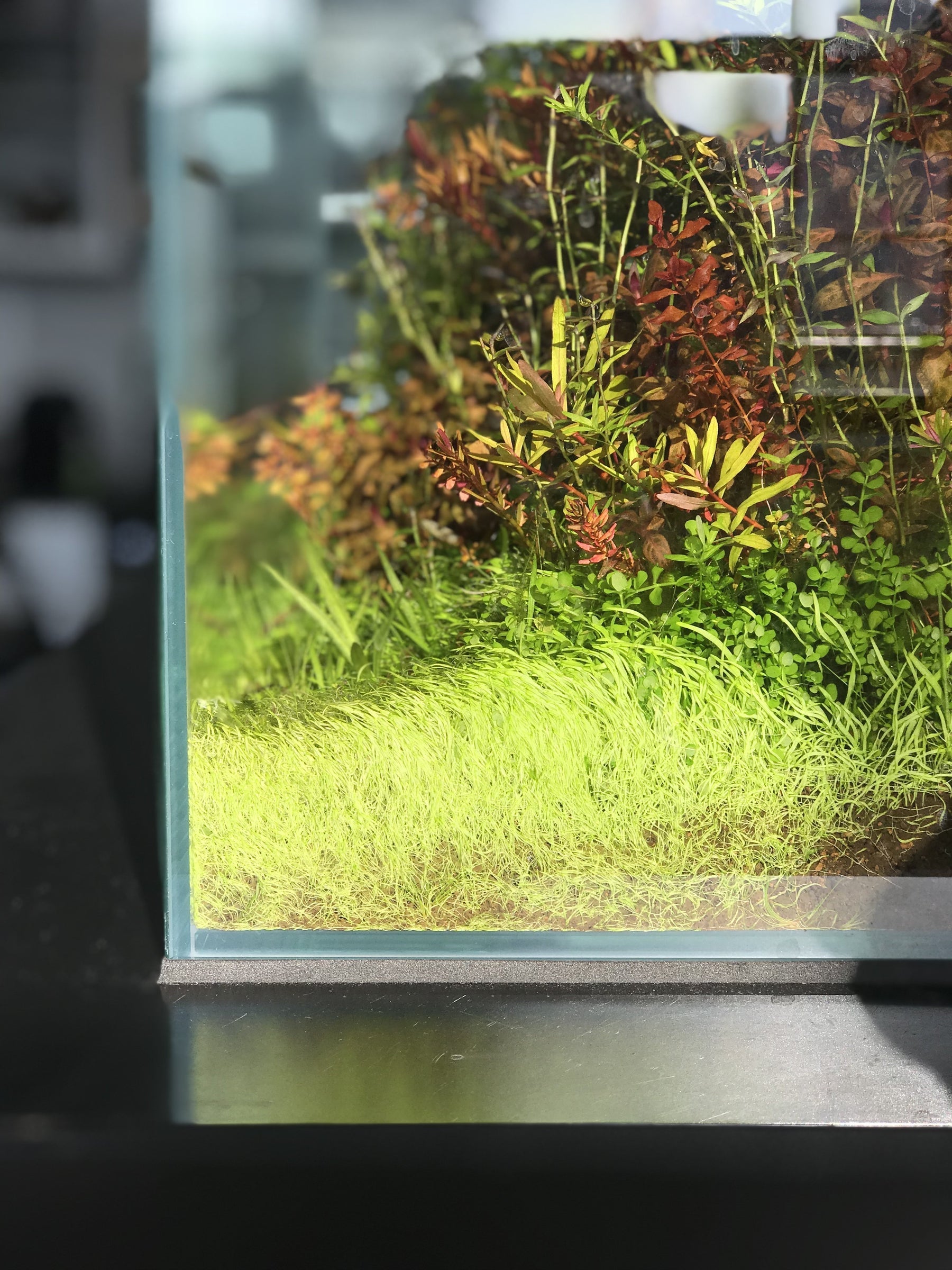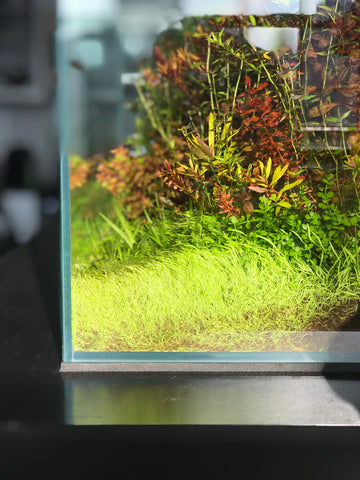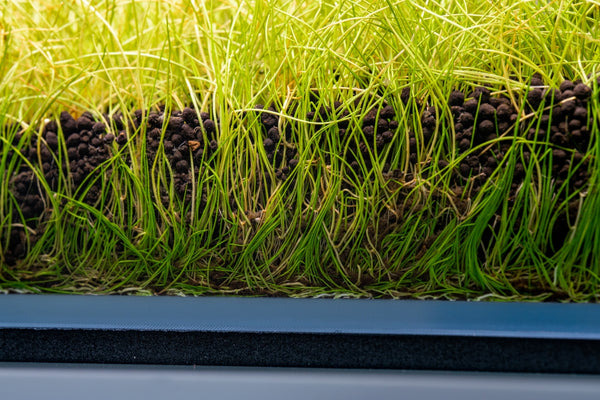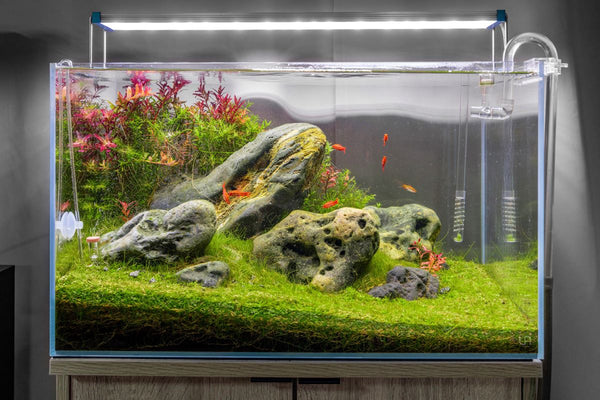
Everything You Need To Know About Carpeting Aquarium Plants
Carpeting plants can seem daunting for new aquascapers. As I contemplated entering the planted aquarium hobby, I was fairly confident that I’d have success growing easy stem plants. However, I was less confident in my ability to grow “ground cover” plants that would form a dense mat in the foreground of a planted tank. As it turns out, there was little need for me to worry.
In this article, we'll go over:
1. The Best "Easy" Carpet Plants
2. Tips for Growing a Lush Aquarium Carpet
Many new aquascapers are intimidated by the idea of achieving a lush carpet in their aquariums. They may believe that only professionals with advanced equipment can achieve this level of beauty and complexity. The misconception that achieving a dense carpet is best left to the pros ultimately boils down to poor plant choice. In fact, with the right plant species, a carpet can even be achieved in a freshwater aquarium without CO2.
Unfortunately, many new aquascapers are unaware of these easier species, and choose much more difficult, temperamental plants such as Dwarf Baby Tears (Hemianthus callitrichoides 'Cuba') or Glossostigma elatinoides. While beautiful, these aquarium carpet plant species are much more reliant on CO2, high lighting, and stable water conditions and parameters.

The Best "Easy" Carpet Plants
Better carpeting plants for beginners (and just as beautiful) would be the Marsilea species (hirsuta or crenata are good choices). Marsilea are tiny freshwater ferns that resemble little individual leaflets (or occasionally, 4-leaf clovers). Micranthemum 'Monte Carlo' (Micranthemum Tweediei), my personal favorite, is very similar to HC, but has slightly bigger leaves and a much more robust growth habit.
Both will grow extremely quickly with CO2, and will still form a carpet (albeit more slowly) even without CO2. In my experience, Monte Carlo will have smaller leaves when grown in a low-tech (non-CO2) environment. This means that beginners can achieve a stunning carpet without the absolute need for advanced equipment.
Falling somewhere in the mid-range in terms of difficulty are the Eleocharis species (dwarf hair grasses or dwarf sagittaria.) Resembling a fine-bladed, grassy lawn, a full dwarf hair grass carpet is both satisfying and somewhat difficult to achieve. No one will have trouble growing the plant, but getting it to form a dense mat is another story.
Unlike some other plants, Dwarf Hair Grass doesn't send out runners as easily, which means you'll have to encourage it to grow horizontally. Trimming the plant regularly with clean aquascaping scissors can help encourage lateral growth, but it can take some time to achieve the desired look.
Overall, it's important for beginners to understand that achieving a lush carpet is not reserved for the pros. By choosing the right plant species and following some basic guidelines for growth, anyone can create a beautiful carpet in their aquarium, regardless of their level of experience or equipment.

Tips for Growing a Lush Aquarium Carpet
Finally, I’d like to offer some tips for growing a successful carpet.
1. Choose the Right Soil
Much like many other endeavors in life, everything will be easier if you start out with a good foundation: aquasoil. A good, nutrient-rich substrate like Ultum Nature Systems Controsoil will provide the perfect medium for a carpet to grow and spread in.
Aquasoil is a substrate that has been specifically designed for planted aquariums, and it can provide a great foundation for growing carpeting plants. Aquasoil is made from natural materials that contain essential plant nutrients, such as nitrogen, phosphorus, and potassium, which are important for the growth and development of healthy plants.
In particular, UNS Controsoil is also known for its ability to buffer the water's pH level, which helps create a stable environment for aquatic plants. Most carpeting plants like relatively soft, acidic water. I keep my tanks at a pH around 6.8, and keep the water hardness relatively low. Using a good quality aquasoil like this can help provide the ideal environment for carpeting plants to grow and spread.
2. Plant the Right Way
I recommend planting before flooding the tank, but be sure to moisten the soil before planting. Then, use thin steel pinsettes to push small groupings of the plants relatively deep into the soil at regular intervals, with just a bit of the plant poking out from the substrate. This way, they will stay rooted when you fill the tank with water and form an even carpet as they spread.
3. Consider Tissue Culture
When choosing live aquarium plants, I’d recommend going with tissue culture specimens. These small, sterile cups of baby plants are ideal for planting in the method described above and can be used without fear of introducing snails, filamentous algae, or other annoying pests into your freshwater tank. Buce Plant has a great selection of tissue culture plants available on their site.

4. Join the High-Tech Game
The most important thing to consider when growing carpet aquarium plants is injecting the water with pressurized CO2. This will provide the plants with plenty of carbon needed to grow and spread.
Carbon is a vital component that plants require to carry out photosynthesis and produce energy. The amount of carbon available in aquariums is limited (especially in low-tech tanks.) which can hinder a plant's growth and health.
Pressurized CO2 injection is one of the most effective ways to provide plants with the necessary carbon for their growth and development. The CO2 will dissolve in the water, allowing the plants to absorb it through their leaves and roots. When the plants have enough carbon, they will grow faster and healthier, resulting in a more beautiful and dense carpet.
Although the cost of a new CO2 system might seem daunting, the benefit of injected CO2 is absolutely worth it. You will see the astonishing difference in the health, growth, and vibrancy of your aquascape.
- Learn more about How to Add CO2 to Your Aquarium
5. Invest in Long-Lasting LED Lighting
A quality LED light fixture is essential to promote healthy plant growth, encouraging them to stay close to the substrate for the best carpeting effect. Twinstar's RGB LED lights are a great choice for aquascaping enthusiasts looking to cultivate a lush carpet of aquatic plants in their freshwater aquariums.
Also, it's important to note that your lighting schedule and light intensity are important for the success of an aquarium carpet. Without enough light, the plants will not be able to photosynthesize efficiently and may become weak, stunted, or die. On the other hand, too much light can cause algae growth, which can compete with the plants for nutrients and harm their growth.
A proper lighting schedule and intensity can also help regulate the plant's circadian rhythm, which affects its growth and development. By providing a consistent light schedule (usually about 6-8 hours per day) and intensity, plants can establish a healthy growth pattern and reach their full potential.
- Learn more about Lighting Requirements for a Planted Aquarium
When quality lighting is combined with a nutrient-rich substrate and pressurized CO2, creating stunning underwater landscapes is achievable. For those passionate about aquascaping, selecting the right equipment for your plants is the key to achieving success in this hobby.

6. Maintenance is Always Key
Simply put, regular maintenance will help your carpet thrive. Water changes are necessary to remove excess nutrients and waste that accumulate in the water column. If neglected, it lead to algae growth and other problems that can negatively affect the carpet's growth.
In addition, regular fertilization will provide the plants with the necessary nutrients to grow and thrive. Without adequate fertilization, the plants can become nutrient-deficient, which can lead to slow growth rate, yellowing leaves, and stunted development.
Fast-growing species, in particular, benefit from aggressive trimming, which encourages them to spread and fill in the carpet. Don’t be afraid to trim your plants aggressively. Frequent trimming of most carpeting plants (especially faster growing species) is essential for promoting lateral growth and keeping the plants healthy.
However, it is important to note that slow-growing species like Marsilea should not be trimmed unless absolutely necessary. These species should only be trimmed when they are sending runners to areas where they are unwanted. By maintaining a regular maintenance schedule and trimming your plants as needed, you can create a lush and healthy carpet in your freshwater aquarium.
Hopefully this brief guide will help you become more confident when dealing with carpeting plants. Don’t be afraid to explore other species that I didn’t mention. Happy scaping!
Tell us - Was this article helpful? Please leave a comment below!
If you have any questions regarding this article, please DM us on Instagram, Facebook, or email support@buceplant.com so we can assist you - @buceplant






Comments
Leave a comment